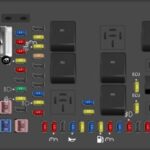The Nissan Leaf, a pioneering electric vehicle, incorporates an essential feature for vehicle diagnostics and monitoring: the OBD2 port. If you’re looking to understand your Nissan Leaf’s health, diagnose potential issues, or even monitor performance metrics, knowing the location of the OBD2 port is the first step. This article will guide you straight to it and explain what you can do once you’ve found it.
Locating the OBD2 Port in Your Nissan Leaf
Finding the OBD2 port in your Nissan Leaf is a straightforward process. Nissan has conveniently placed it in an easily accessible location for quick diagnostics.
The OBD2 port in a Nissan Leaf is located beneath the steering column, on the driver’s side. You won’t need any tools to access it. Simply look under the dashboard, just below where the steering column is positioned. You’ll typically find it in the vicinity of the pedals and above the driver’s side footwell.
Nissan Leaf OBD2 port location under the steering column. This diagnostic connector enables mechanics and car owners to access vehicle data for troubleshooting and performance monitoring.
This port is designed as a Type A diagnostic connector, adhering to the ISO 15031-3 standard, also known as SAE J1962. This standardization means it’s compatible with a wide range of OBD2 scanners and diagnostic tools. The connector features 16 pins arranged in two rows, a common configuration for modern vehicles.
Understanding the Nissan Leaf OBD2 Port and CAN Buses
The OBD2 port is not just a connector; it’s your gateway to the Nissan Leaf’s internal communication network. Specifically, it provides access to the vehicle’s CAN (Controller Area Network) buses. In the Nissan Leaf, there are three primary CAN buses:
- AV-CAN: This bus handles messages related to the vehicle’s audio-visual systems, primarily the display screen and infotainment functions.
- Car-CAN: As the name suggests, Car-CAN manages general vehicle operations. Interestingly, this bus also carries EV-related messages, making it a central hub for much of the car’s data.
- EV-CAN: Exclusively dedicated to the electric vehicle components, EV-CAN transmits messages concerning the battery system and the drive system. This is crucial for monitoring the health and performance of your Leaf’s electric powertrain.
These CAN buses in the Nissan Leaf utilize the ISO 15765-4 CAN protocol, operating at 500 kBd with an 11-bit identifier. This protocol ensures reliable communication between the vehicle’s electronic control units (ECUs) and any diagnostic tools connected to the OBD2 port.
Contact Designation of the OBD2 Port
The 16 pins of the OBD2 port are not all the same; each pin serves a specific purpose. While some pins have mandated designations across all OBD2 compliant vehicles, others are manufacturer-specific.
Pin configuration of the Nissan Leaf OBD2 connector, illustrating the function of each pin in relation to power supply, ground, and specific CAN bus communication lines.
In the Nissan Leaf, you’ll find five pins with standard OBD2 designations:
- Chassis Ground (Pin 4): Provides a ground connection to the vehicle chassis.
- Signal Ground (Pin 5): Establishes a common ground reference for信号 transmission.
- Car-CAN High (Pin 6): The high signal line for the Car-CAN bus.
- Car-CAN Low (Pin 14): The low signal line for the Car-CAN bus.
- Permanent +12V DC (Pin 16): Provides a constant 12V power supply, even when the vehicle is off.
Additionally, Nissan utilizes other pins for Leaf-specific functions:
- AV-CAN Low (Pin 3): The low signal line for the AV-CAN bus.
- +12V DC when vehicle powered on (Pin 8): Provides 12V power only when the vehicle is turned on.
- AV-CAN High (Pin 11): The high signal line for the AV-CAN bus.
- EV-CAN Low (Pin 12): The low signal line for the EV-CAN bus.
- EV-CAN High (Pin 13): The high signal line for the EV-CAN bus.
Understanding this pinout, detailed in the table below, is essential for anyone developing or using advanced diagnostic or communication tools with the Nissan Leaf.
| Pin | Symbol | Designation |
|---|---|---|
| 1 | No connection | |
| 2 | No connection | |
| 3 | AV‑CAN low | |
| 4 | Chassis ground | |
| 5 | Signal ground | |
| 6 | Car‑CAN high | |
| 7 | No connection | |
| 8 | +12 V DC when vehicle powered on | |
| 9 | No connection | |
| 10 | No connection | |
| 11 | AV‑CAN high | |
| 12 | EV‑CAN low | |
| 13 | EV‑CAN high | |
| 14 | Car‑CAN low | |
| 15 | No connection | |
| 16 | Permanent +12 V DC |
Conclusion
Locating the OBD2 port in your Nissan Leaf is a simple task, thanks to its accessible placement under the steering column. This port serves as a crucial interface for accessing valuable vehicle data through the CAN bus system. Whether you are a car owner wanting to monitor your vehicle’s health, a mechanic diagnosing a problem, or a developer working on automotive applications, understanding the OBD2 port location and its capabilities in the Nissan Leaf is a valuable piece of knowledge. Knowing where this port is located empowers you to take a deeper look into your electric vehicle and ensure it runs smoothly for years to come.

